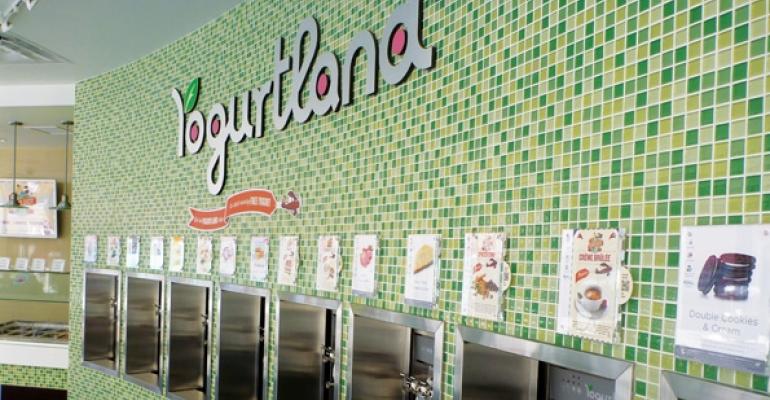Yogurtland is exploring menu extensions that will put its locations to better use, including potentially adding Greek yogurt, yogurt cakes and cookie sandwiches to its menu.
Craig Takiguchi, the Irvine, Calif.-based chain’s vice president of brand management, has taken on the mission of differentiating the 300-unit frozen yogurt chain in an increasingly competitive market.
For existing locations, Takiguchi is working on ways to make more efficient use of the unit footprint, which may include extending dayparts.
“We’re trying to maximize real estate within each store,” Takiguchi said. “Twelve hundred square feet made sense at one time, but now we want to be ultra efficient.”
Most locations don’t open until 11 a.m., and most sales occur after 3:30 p.m., but franchisees must still pay a full day’s rent, he said. So Yogurtland is testing ways to grow within its existing four walls.
For example, one unit is testing a fresh Greek yogurt program, where customers can create their own yogurt parfaits with fruit or granola toppings, as a breakfast item. Pinkberry moved in that direction in 2012.
Yogurtland is also testing various pastries, including a croissant-waffle called a Croiffle and a cinnamon roll-waffle dubbed a Cinnaffle.
The company will test the program in three more corporate units before it decides to roll it out. Even then, it will likely be optional for franchisees, depending on the location and whether it makes sense, he said.
In addition, Yogurtland is taking aim at the ice cream market with innovations like a frozen yogurt sandwich and frozen yogurt cakes for special events. Takiguchi promised other innovations to come.
“I feel like we’re in the second inning of a nine-inning game with overtime. We’re in a position of strength and we’re going to double down in terms of innovation,” he said. “We don’t want to stay still. We want to evolve the concept and the industry.”
Founded in 2006, Yogurtland pioneered the concept of pay-by-the-ounce, self-serve frozen yogurt, which most competitors quickly adopted. With franchised brands like Pinkberry, Menchie’s and Red Mango battling for market share, along with older concepts like TCBY and many smaller copycat brands, the frozen yogurt segment has become extremely competitive — some say oversaturated.
Yogurtland founder Phillip Chang tapped Takiguchi for the position in August 2014. He had recently returned to helm the frozen yogurt chain after stepping away for about six months to focus on charity work. He remained chairman during that time.
While he was away, Chang was not happy with the way Yogurtland was approaching its growth as a national brand, Takiguchi said.
Upon returning as president and CEO in July 2014, Chang and made some changes to the executive team, resulting in the departure of CEO Huntley Castner and several other executives
Takiguchi previously helped build the Beard Papa Sweets Café cream puff chain in the U.S. and internationally. Beard Papa was sold to a Japanese conglomerate in 2013.
Takiguchi said he and Chang had similar philosophies, and once discussed developing a business together, but the timing was never right.
At Yogurtland, Takiguchi took on the multiple roles of leading the operations, marketing, product development and franchise development teams. He is challenged with “growing [the brand] up big, but staying small,” he said.
“You have to wear every hat and wake up every morning and problem-solve,” he said. “It reduces the level of bureaucracy.”
The frozen yogurt space has since cooled a bit, and some competitors are closing locations, Takiguchi said.
“The pie isn’t growing, but the players are shifting,” he said.
That presents an opportunity for Yogurtland to capture locations. The chain has maintained a stronghold on the West Coast, where same-store sales have topped 20 percent year to date in mature markets, Takiguchi said.
The brand’s move east, where it is not as well known, has been more challenging, Takiguchi said. The company will focus growth for now in states including Texas, Nevada and Arizona, as well as the Pacific Northwest region.
Yogurtland is looking to seed new markets with company units, and it has developed nontraditional formats with the goal of pushing the brand into more airports and college campuses.
According to Nation’s Restaurant News’ Top 200 census, Yogurtland reported domestic systemwide sales of $141.4 million, a 7.1-percent increase from 2013, when sales grew by 17.7 percent over 2012. The chain ended fiscal 2014 with 294 units, including 20 company and 274 franchised locations, an increase of 22 percent over 2013.
However, Yogurtland’s franchise disclosure documents indicated that unit sales for the 176 locations open the entire year in 2013 averaged $668,934, a 6.5-percent decrease from 2012.
This story has been revised to reflect the following corrections:
Correction: April 14, 2015 An earlier version of this story misstated the typical size of a Yogurtland unit. They are typically 1,200 square feet.
Correction: April 15, 2015 An earlier version of this story did not specify domestic systemwide sales.
Contact Lisa Jennings at [email protected].
Follow her on Twitter: @livetodineout

